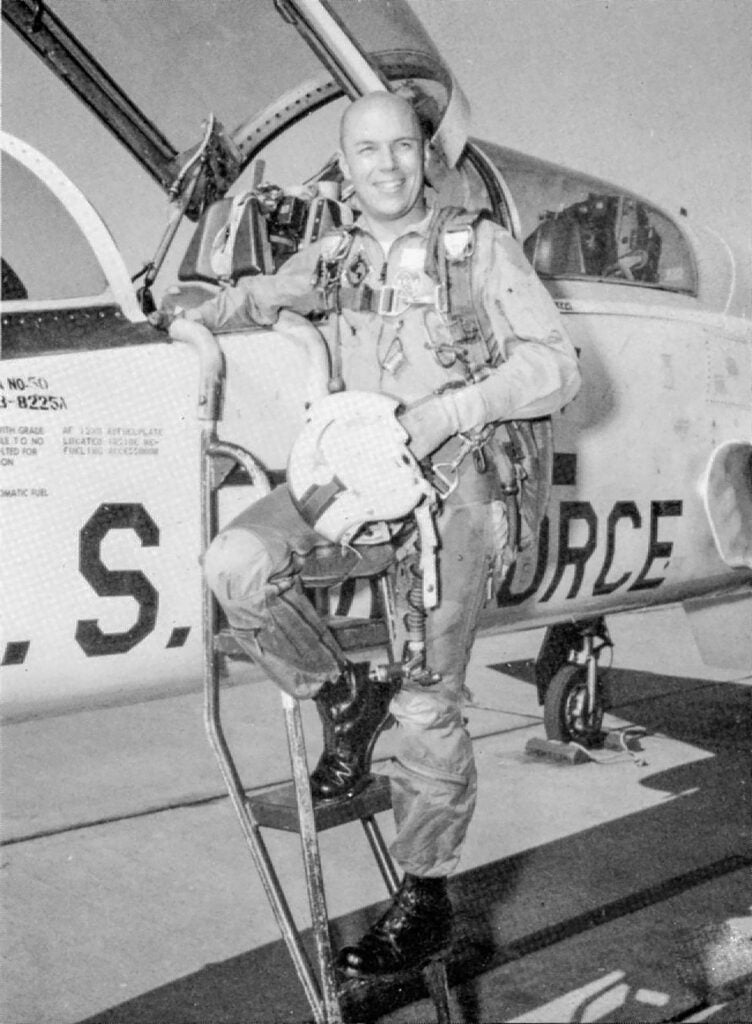The spacewalk that saved Hubble
Published 9:23 am Tuesday, March 19, 2024
|
Getting your Trinity Audio player ready...
|
By Bonnie Bartel Latino
Columnist
My husband, Tom, as Tommy Latino became known to his friends during Undergraduate Pilot Training (UPT). He and 83 other students were assigned to the 3500th Training Wing at Reese Air Force Base, Texas. After 53 weeks of training, student pilots in Class 69-06 hoped to earn their wings, graduate and enter the USAF’s real world. Only 54 would make it.

Dr. Story Musgrave during his Undergraduate pilot training days at Reese AFB, Texas, with the T-38 Talon. (Photo from the 69-06 UPT yearbook, the “HA HA”.) | Submitted photo
Two flights, each of approximately 42 men comprised 69-06. Only one African American became a member and graduated with 69-06, and women didn’t enter the Air Force’s UPT until early 1976. Most students were Air Force officers, but not all were lieutenants, a few were higher-ranking officers retraining from previous USAF career fields. One was a Norwegian Foreign Exchange pilot. Dr. Story Musgrave, a 33-year-old civilian, would become the most well-known graduate of 69-06.
Born in Massachusetts, Musgrave considered Kentucky home. After graduating from high school in 1953, he enlisted in the United States Marine Corps. He served most of his enlistment in the Far East aboard the carrier U.S.S. Wasp, working in technical positions before being assigned as an aircraft crew chief. By 1964, he had earned his medical degree from Columbia University. Even before Musgrave earned his pilot’s wings, the National Aeronautics and Space Administration (NASA) had selected and trained him to be an astronaut-scientist. As a flight student (1968-69), Musgrave broke every student performance record and earned the coveted Commander’s Trophy for the Outstanding Graduate of Class 69-06 at Reese AFB.
Musgrave’s achievements after he earned the coveted wings of a U.S. Air Force aviator are so vast and diverse, I quote from the August 2010 Smithsonian about a miniscule portion of his later accomplishments: “Former astronaut Story Musgrave is a veteran of six space shuttle flights on five different orbiters. He has seven academic degrees, including a doctorate in medicine. During his 30 years with NASA, he worked as a part-time trauma surgeon. Musgrave has logged 18,000 hours in 160 types of aircraft…”
In the early 1980s, I picked up a Sunday edition of the New York Times. The joyous face of astronaut Story Musgrave grinned at me from the front page! He was just back from a NASA space mission. However, his name wouldn’t become well-known until a 1993 space shuttle flight, during which he and a crew of six other astronauts repaired the Hubble Telescope for the first time in orbit.
According to an April 23, 2015, online BBC feature article titled, “The spacewalk that saved Hubble”, Musgrave had worked on the plans and design for the (future) Hubble Telescope since the early 1970s. From that time, NASA had planned for astronauts to regularly service and update the Hubble. That was why Musgrave had originally been assigned to the project. NASA tasked Musgrave to look at all of Hubble’s various parts and brainstorm for any failure that might conceivably happen. He was also tasked to work out solutions for each proposed problem, including planning exact spacewalks and tools required to make repairs.
When NASA finally launched the Hubble Telescope in April of 1990, it soon became obvious that there was a disastrous optics problem. Pictures captured by the telescope appeared blurry. A complete investigation revealed that Hubble’s primary mirror had caused America’s $1.6 billion observatory to be unable to accurately focus. Even though a manufacturing error was at fault, the failure created enormous embarrassment for NASA. Especially, as the BBC article noted, only four years after the Space Shuttle Challenger explosion killed six astronauts.
Once Hubble’s problem had been discovered, who better than Story Musgrave to lead a servicing mission on NASA’s Extra Vehicular Activity (EVA) flight. On December 2, 1993, the space shuttle Endeavour launched a crew of seven on Mission STS-61 to correct Hubble’s optical component and make other adjustments. Astronauts Musgrave and Jeffrey Hoffman made the first servicing spacewalk to the Hubble. They did this while 370 miles above Earth. A robotic arm anchored them to the telescope so they could replace electrical circuits, control units and gyroscopes. At eight hours, this was one of NASA’s longest EVAs in space. Various astronauts on STS-16 made four more Hubble servicing spacewalks, which ended on December13, 1993. NASA Mission STS-61 became one of NASA’s most significant and important space missions. Story Musgrave retired from NASA in 1997. He is now 88 years old. He has had seven children, one of whom is deceased.

